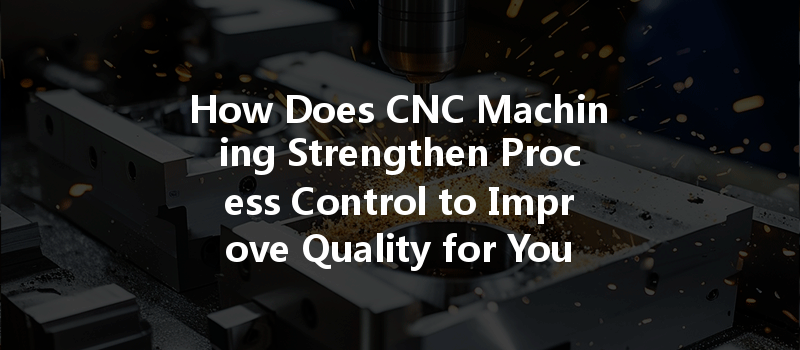Opening
Did you know that about 70% of manufacturing defects can be traced back to inadequate process control? In today’s competitive manufacturing landscape, ensuring quality isn’t just a goal—it’s a necessity. One of the most effective ways to enhance process control and quality is through CNC (Computer Numerical Control) machining. By harnessing advanced technologies, CNC machining not only streamlines production but also boosts the precision and consistency needed to thrive in any project. But how exactly does it achieve this? Let’s delve into the world of CNC machining and explore how it strengthens process control to improve quality.
—
Content
Understanding CNC Machining
CNC machining utilizes computer programming to dictate the movements of manufacturing equipment. Unlike traditional machining, which requires manual input, CNC machines operate on automated technology that interprets a design through a set of precise commands. This level of automation leads to greater accuracy and efficiency while minimizing human error.
The most common CNC machining processes include milling, turning, electrical discharge machining (EDM), and grinding. Each process involves unique tools and methods that inherently promote high-quality outcomes. By setting the parameters at the design stage, manufacturers can enforce strict guidelines that ensure consistent product quality from the first item to the last.
One of the most significant advantages of CNC machining is its ability to provide exceptional precision and accuracy. The machines can execute complex designs with tight tolerances, which is crucial in industries where even the slightest deviation can lead to catastrophic failures—think aerospace or medical devices.
Solution: To leverage CNC machining for enhanced precision, it’s crucial to invest in high-quality machines equipped with advanced technology. Additionally, implementing thorough quality checks at each stage of the process, from design to the finished product, ensures that precision is maintained throughout.
Another area where CNC machining excels is consistency. Once a design is created, the CNC machine can duplicate the same process across multiple product runs with identical results, significantly reducing variance.
Solution: Utilizing standardized setups and workflows enables manufacturers to replicate quality in every batch. Regular maintenance of CNC machines also plays a role in sustaining performance consistency.
CNC machining allows for the integration of sophisticated software that enables real-time monitoring of operations. This proactive approach provides immediate feedback on the machining process, allowing operators to make on-the-fly adjustments.
Solution: Invest in monitoring systems that provide data analytics on production performance. Using this data, managers can identify inefficiencies and areas of potential improvement. Continuous optimization based on timely insights will also reinforce process control.
In CNC machining, the choice and management of tools can drastically affect quality. With tools designed specifically for certain materials or processes, it becomes easier to maintain sharpness and performance.

Solution: Implement a tool management system that tracks tool usage and replacement schedules. Ensuring that tools are appropriate for the material type can mitigate the risk of damage or inaccuracies, fostering better overall machining quality.
CNC machining integrates quality assurance (QA) procedures at various stages of the process. Automated inspections, often using advanced metrology equipment, identify defects or inconsistencies before products leave the shop floor.
Solution: Establish a dedicated QA team that works alongside production staff to conduct regular inspections. This proactive approach leads to early detection of any issues, ensuring that only products meeting quality standards reach customers.
CNC machines significantly reduce lead times by allowing manufacturers to optimize their production workflow. By minimizing setup times and increasing machine speeds, factories can maintain a high level of productivity without sacrificing quality.
Solution: Adopt lean manufacturing principles alongside CNC technology. Streamlining operations reduces waste and helps maintain a focus on quality. Establishing clear lines of communication between engineering and production teams fosters a culture of quality and efficiency.
While technology plays a pivotal role in CNC machining, human expertise remains equally important. Skilled technicians who understand both CNC operations and quality control processes can adeptly oversee production.
Solution: Invest in ongoing training and development for staff involved in CNC machining. Comprehensive training programs not only elevate employees’ skills but also instill a quality-first mindset that aligns with modern manufacturing practices.
Case Studies: Successful CNC Implementation
Ending
In conclusion, CNC machining significantly strengthens process control which, in turn, enhances the quality of manufactured products. From the precision of automated processes to the real-time monitoring capabilities and the importance of skilled personnel, each facet plays a meaningful role in achieving superior outcomes.
As industries continue to advance with automated solutions, understanding and implementing CNC machining becomes paramount for businesses to maintain competitive advantage. Quality can no longer be an afterthought— it must be ingrained into the very fabric of the manufacturing process. For any company looking to stand out, investing in CNC machinery and best practices can mean the difference between mediocrity and excellence. Consider these insights and start thinking about how your projects can benefit from the transformative power of CNC machining today!



